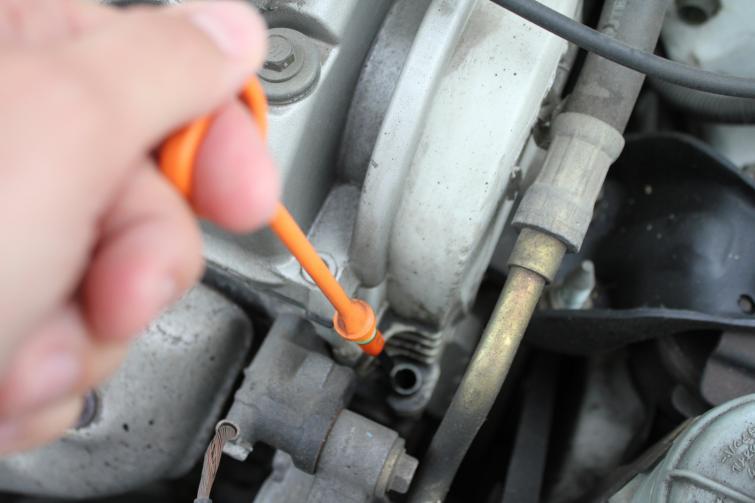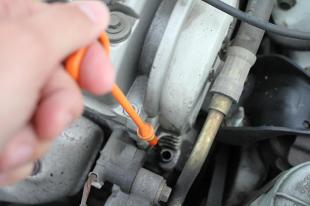
Changing the oil in a car engine - a guide
 When choosing oil for your car, you should first of all be guided by the recommendations of the car manufacturer. In cars that are about ten years old, the semi-synthetic oil, appropriately mentioned in the manual, can be replaced with a more modern "synthetics".
When choosing oil for your car, you should first of all be guided by the recommendations of the car manufacturer. In cars that are about ten years old, the semi-synthetic oil, appropriately mentioned in the manual, can be replaced with a more modern "synthetics".

Engine oil is one of the most important fluids in a car. It is responsible for lubricating the drive unit, reduces friction of engine parts during operation, keeps it clean, and also acts as a cooling device.
That is why it is so important to use the oil recommended by the car manufacturer - it is of great importance for keeping the engine in good condition.
On the shelves of stores, we can find synthetic, semi-synthetic and mineral oils.
As Pavel Mastalerek, Castrol's technical manager, explains to us, they differ in base oils and enrichment packages.
Synthetic oils
Synthetic oils are currently the most researched and most commonly developed oils, making them better suited to the requirements of engine manufacturers, and these motors last longer and run more efficiently.
Synthetics are superior to mineral and semi-synthetic oils in all respects. They can operate at higher temperatures and higher pressure on lubricated surfaces than mineral or semi-synthetic ones. Due to their resistance to high temperatures, they do not accumulate in the form of deposits on the internal parts of the engine, which prolongs its service life.
See also: Oil, fuel, air filters - when and how to change? Guide
At the same time, they are quite fluid at low temperatures - they remain fluid even down to minus 60 degrees Celsius. Therefore, they make it easier to start the engine in winter, which is difficult when using thick mineral oils in severe frosts.
They also reduce frictional resistance and fuel consumption. They better keep the engine clean by reducing deposits in it. Their replacement intervals are longer because they age more slowly. Therefore, they can operate in the so-called long life mode, i.e. increased mileage between oil changes in a car, although especially in cars with a turbocharger, it is safer to change the oil every 10-15 thousand. km or once a year. Most new cars use synthetics.
Semi-synthetic oils
Semi-synthetics are similar in many properties to synthetics, they provide better engine protection than mineral oils. There is no rule when and at what mileage you should switch from synthetic to semi-synthetic oil. Even if the car has driven several hundred thousand kilometers, but the drive has no signs of wear and tear and is fully functional, it is not recommended to refuse synthetics.
Semi-synthetic can be a solution if we want to save money. Such oil is cheaper than synthetic and provides high-level engine protection. A liter of synthetic oil usually costs more than PLN 30, prices can even reach PLN 120. We will pay about PLN 25-30 for semi-synthetics and PLN 18-20 for mineral water.
Mineral oils
Mineral oils are the worst of all types. It is advisable to use them in old engines with high mileage, as well as in case of oil burnout, i.e. when the car consumes too much oil.
See also: Timing - replacement, belt and chain drive. Guide
If we are buying a used car, like a 15 year old car that has a very worn engine, and we are not sure what oil was used before, it is safer to choose a mineral or semi-synthetic oil to avoid washing off carbon deposits - this can lead to leakage or a decrease in oil. engine compression wear.
– When we are sure that the car, despite the high mileage, was running on synthetic or semi-synthetic oil, you can use the same type of oil, but with a higher viscosity, recommends Pavel Mastalerek. – Allows you to significantly reduce engine oil consumption, as well as reduce the noise emitted by the drive.
Oil markings
The most popular viscosity parameters (oil resistance to flow - viscosity is often confused with density) for synthetics are 5W-30 or 5W-40. Semi-synthetics are practically the same viscosity - 10W-40. Mineral oils 15W-40, 20W-40, 15W-50 are available on the market.
The Castrol expert explains that the index with the letter W indicates viscosity at low temperatures, and the index without the letter W - at high temperatures.
The lower the viscosity, the lower the resistance of the oil and therefore the lower the power loss of the engine. In turn, higher viscosity provides better engine protection against wear. Therefore, the viscosity of the oil must be a compromise between these extreme requirements.
Petrol engines, diesels, cars with LPG installation and DPF filter
Quality standards for gasoline and diesel engines differ, but the oils available on the market generally meet both. As a result, it is difficult to find an oil designed exclusively for diesel or purely gasoline engines.
Much greater differences in oils are due to the design of engines and their equipment. Oils differ due to the use of DPF (FAP) particulate filters, TWC three-way catalysts, common rail or unit injector injection systems, or long oil life. These differences must be taken into account when choosing engine oil.
It is worth adding that oils should be used for cars with a DPF filter.
produced by low-ash technology (Low SAPS). This significantly reduces the filling rate of the particulate filters. Such oils in the ACEA classification are designated C1, C2, C3 (most often recommended by engine manufacturers) or C4.
– In oils intended for passenger cars, it is very difficult to find low-ash oils other than synthetic ones, says Pavel Mastalerek. – Low-ash oils are also used in truck oils, and here you can find synthetic, semi-synthetic and even mineral oils.
See also: Gearbox operation - how to avoid costly repairs
In the case of cars with a gas installation, there are oils on the market with labels on which there is a description that they are adapted for such cars. However, global manufacturers do not specifically indicate such oils. The parameters of products for gasoline engines successfully meet all requirements.
What is a replenishment?
A liter of oil in the trunk for possible topping up of its level in the engine is vital - especially if we are going to longer routes. For refueling, we must have the same oil as in the engine. Information about this can be found in the service book or on a piece of paper left by the mechanic under the hood after replacing it.
You can also read the owner's manual for the vehicle. The parameters are indicated there: viscosity - for example, SAE 5W-30, SAE 10W-40, quality - for example, ACEA A3 / B4, API SL / CF, VW 507.00, MB 229.51, BMW Longlife-01. Thus, the main requirements that we must comply with are the quality and viscosity standards specified by the manufacturer.
However, it may happen that refueling is required during the trip, and the driver does not know what kind of oil the serviceman filled in. According to Rafał Witkowski of oil distributor KAZ, it is best to buy the best at gas stations or auto shops. Then the likelihood that this will worsen the properties of the oil in the engine will be lower.
There is another way out. On the Internet, on the websites of engine oil manufacturers, you can find search engines that allow you to select lubricants for hundreds of car models.
Oil change
We must follow the manufacturer's recommendations regarding replacement timing. This is done together with the oil filter, usually every year or after 10-20 thousand kilometers. km. But for new engines, the mileage can often be longer - up to 30 10. km or two years. However, it is better to play it safe and change the oil every 15-XNUMX thousand. km. Especially in cars with a turbocharger, which requires good lubrication.
More frequent replacement is also recommended in gas powered vehicles. Oil life should be about 25 percent shorter. The reason is that additives in oil are consumed faster, incl. due to the presence of sulfur and higher operating temperatures.
See also: Gas installation - how to adapt the car to work on liquefied gas - a guide
Remember to check the oil level regularly - at least once a month. Regardless of whether we have an old car or a new one.
An oil change costs about PLN 15, although it is often free if you buy oil from a service shop. It can also be more expensive if the client brings their own oil. The filter costs about 30 PLN.
Petr Valchak